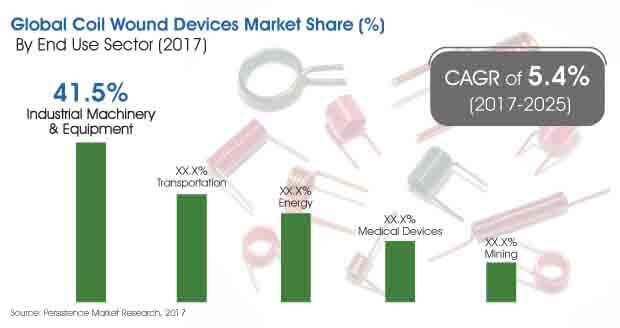Coil Wound Devices Market Segmented By DC motors, AC motors as Electrical Motors with Low Voltage, Medium Voltage, High Voltage Transformers, Valves and Actuators, Switches, Contactors and Relays Application in Sensors, Bobbins, Electromagnetic Coils, Solenoids, Lightning Coil
Industry: Industrial Automation
Published Date: January-2018
Format: PPT*, PDF, EXCEL
Delivery Timelines: Contact Sales
Number of Pages: 244
Report ID: PMRREP21733
Increasing per capita consumption in emerging countries has led to an increasing demand for efficient coil wound devices for various industries such as automotive, food and beverages, pharmaceuticals, and agriculture, among others. This, in turn, has increased the shipment of electronic devices, and appliances which in turn has been a driving factor for the global coil wound devices market. As of 2014, the urban population accounted for 54% of the total population globally and is expected to further increase at a healthy pace. Substantial growth in the service and manufacturing sectors has led to a healthy growth in GDP worldwide. This, in turn, has had a positive impact on the global spending on smartphones, thereby eventually impacting the demand for coil wound devices.
Global GDP is projected to register a steady growth during the forecast period owing to higher rate of industrialization in emerging economies such as Asia Pacific. Moreover, increasing adoption of coil wound devices in the automotive sector is anticipated to fuel the demand in near future.
Advancement and replacement of aging power infrastructure in the U.S. is one of the key factors driving the coil wound devices demand in North America. The aging electricity infrastructure will require new technologies to enable better failure detection. Traditional systems do not meet many emerging trends, such as growing penetration of distributed generation resources and need for greater resilience.
The new transmission technologies combine power electronic devices with capacitors and inductors to provide a range of controlling capabilities for transmission and distribution systems. The demand for coil wound devices, especially transformers, is anticipated to witness a notable growth as they are important components that are used for carrying out electric grid transition from traditional designs to the designs of future in the coming years.
In 2017, the U.S. government decided to withdraw from the 2015 Paris Climate Agreement. This step is likely to cause solar and wind deployment rate to move slowly, ultimately slowing down the ongoing transition to renewable energy. The pace of renewables growth will also be affected by numerous separate policy decisions, including the Clean Power Plan, Investment Tax Credit and Production Tax Credit for renewables and by the addition or reduction of restrictions on fossil fuel production and consumption.
It is anticipated that these steps will negatively impact passive components demand, devoted to developing environment-friendly technologies for alternative energy. However, the impact is expected to remain minimal, largely offset by other driving forces.

As per the data provided by Persistence Market Research, the transportation segment in the end-use sector was estimated to be valued at nearly US$ 18,200 Mn in 2017 and is anticipated to reach a valuation of nearly US$ 27,900 Mn in 2025, exhibiting a CAGR of 5.5% during the period of assessment 2017-2025. The medical devices segment in the end-use sector was estimated to be valued at nearly US$ 9,000 Mn in 2017 and is forecasted to reach a valuation of nearly US$ 14,200 Mn in 2025, displaying a CAGR of 5.8% during the period of forecast.
| Attribute | Details |
|---|---|
|
By Application |
|
|
By Device Type |
|
|
By End Use Sector |
|
|
By Region |
|
To know more about delivery timeline for this report Contact Sales
